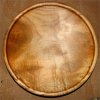Suggestions to soak the parts that didn't take as much oil with more of the same are the ones I'd follow. That's the only "problem" here. Some end grain took up more oil than the face grain, and looks darker for the time being. Linseed is fine, of course. Nothing magic about soy or tung. Linseed's got a nice warm look a lot of people love.
You can put oil-based varnish rather than BLO on for a harder finish.
If you're set on removing what you have, it will be pretty tough. Rather than soak and raise all the commotion and grain, I'd iron the surface with absorbent towels between the heat and the oil. As it flows it'll get absorbed. Long, unnecessary project, really. Longer the oil has had to cure, the less effective this will be.
Here's some maple with the first coat of linseed. Looks uneven, but two coats of dilute varnish brightened and evened it up delightfully.

